#JAMES GANG 1970
Text
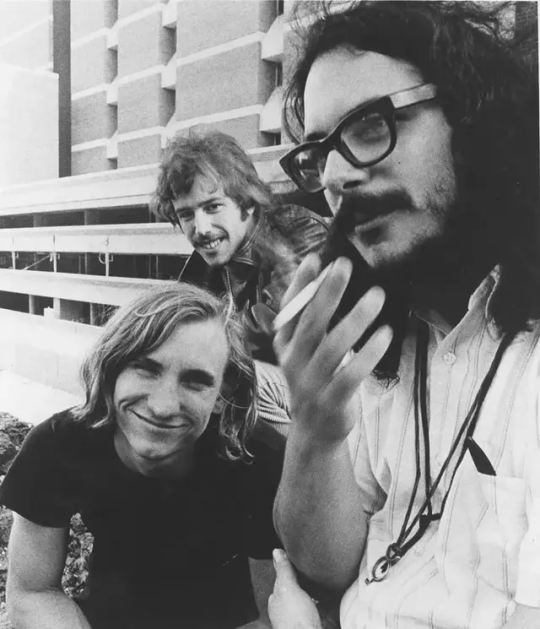
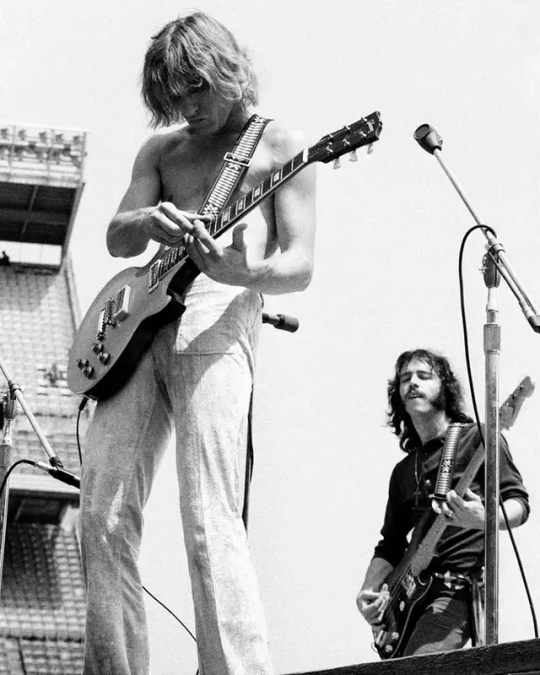
A STAPLE ROCK ACT FOR TRUE HEADS AND/OR POWER TRIO CONNOISSEURS
PIC(S) INFO: Spotlight on Cleveland, Ohio-formed rock band JAMES GANG, c. 1970, "Rides Again" line-up.
THE JAMES GANG:
Joe Walsh -- guitars, keyboards, vocals
Jim Fox -- drums, percussion
Dale "Bugsley" Peters -- bass guitar
PIC #2: Joe Walsh and Dale Peters of JG performing at the 12-hour "summer festival for peace" at Shea Stadium in New York, August 1970. 📸: New York Daily News.
Source: www.loudersound.com/features/james-gang-story.
#THE JAMES GANG#JAMES GANG band#1970#THE JAMES GANG band#1970s#70s rock#Power Trio#Joe Walsh#70s#Rock photography#Jim Fox#Dale Peters#Concert photography#Rides Again 1970#JAMES GANG 1970#Shea Stadium NYC#Super Seventies#Shea Stadium#Drums#Guitarist#Bassist#Photography#NYC
2 notes
·
View notes
Text

13 notes
·
View notes
Text
Chapter 2 - Dusk
Chapter 2 of my fic "Dusk Til Dawn" which can be found on AO3!
Native New Yorker - Odyssey
It was an ordinary day. Nothing out of the unusual. I woke up on time, which I always did, drank my tea, ate my toast, applied my makeup, threw my work uniform on, and was out the door in about forty-five minutes. I lugged my tote bag over my shoulder, which kept slipping off my coat - a ridiculously expensive purchase I had bought one night during a cocaine bender. I quit drugs the next day when I woke up to a fur coat perched on the edge of my bed, a half naked man snoring beside me, and a cat I had never seen before meowing at my door.
This fur coat was a natural tan color and had cost me a hundred and fifty dollars, of which I certainly could not afford. I walked the four blocks to the diner where I worked, a cigarette perched between my fingers. My work uniform was simple - skin color stockings, and a stupid powder blue collared dress that came to my mid-thighs. I guess the owner wanted the “pretty girls to attract customers” but the only thing it attracted was unwanted comments.
“Mornin’ Arthur.” I hollered when I sauntered through the door into the mercifully warm diner.
My manager appeared from the back, carrying boxes from a new shipment, a cigarette hanging from his lips. “Mornin’ Aurora. You can start by sortin’ silverware and filling up those damn ketchup bottles. Closers neglected yet again.”
I rolled my eyes and huffed. The closers could never do anything fucking right. I worked mornings during the week and Friday and Saturday nights. Sunday was my only day off. I put a few quarters into the jukebox and soon David Bowie was serenading me as I rolled silverware into their respective paper napkins.
As customers started to trickle in this Thursday morning, I abandoned my side work to serve them. The day passed as normal. I got off shift around 5:15 and after a hamburger, I slipped on my fur coat and headed back towards my apartment. These four blocks were often filled with annoying teenagers shouting things out at me.
Complaints aside, I actually didn’t mind the walk. I relished the crisp air in the colder months and the soft breeze in the warmer months. This walk was a time for thinking. I zoned out and allowed any thoughts in my head to turn over and salivate. It usually took me approximately one cigarette to get home. Sometimes two if it was the summer and I was in a good mood.
Greenpoint, Brooklyn, of which I called home, was nice enough. I thought back to the expensive brownstone that my aunt, whom I used to live with, owned in Williamsburg. She kicked me out when I was nineteen after she found me passed out in the bathtub the morning after a bender. I ashed my cigarette and walked up my steps to a brownstone that had been split into four different apartments. The flight of stairs up to my second floor residence was always littered with cigarette butts but at least it was safe.
Once I took off my coat, I brewed a pot of tea. My aunt always had the most disgusting coffee brewing so I never got into that harsh black liquid. I shuddered just thinking about it. I wondered how she was doing. After I moved out, we called each other every now and then for a few months but that slowly trickled to nothing. It’s been two years since I talked to her.
Our relationship was never that close and that was fine with the both of us. We were more like roommates than relatives. She had her life, I had mine. The only rule we had was to keep the noise down. I moved in with my aunt at ten years old when my mother was murdered. My father was so distraught over her death he fled the country and started a new life for himself. I never really cared too much to contact him.
Only once when I was 17 did I try to find him but it led to too many dead ends. And that was the end of my curiosity. I found out during this research that my mother was shot during a gang fight when she got caught in the misfire. Sometimes I had nightmares about her mangled body on the street, cold and lifeless. The funeral was stuffy and quiet. I don’t recall much else.
I attended a public school in Brooklyn that I can’t quite recall. Could have been PS 144 or PS 81. I can’t say I learned too much. I had my first job waitressing at 16 and subsequently stopped caring about school. However, my aunt disagreed with this belief. She held education to a high regard and wouldn’t let me drop out. The only time she showed real parenting. I walked across the graduation stage alone and came home to my aunt who was two bottles of wine deep, passed out on the couch watching “Jeopardy” alone.
We were both addicts and I guess that’s why we didn’t work out as “roommates”. Our front door was a revolving portal for men, booze, and bad decisions. I guess that’s where all my bad influence comes from, but I probably would have ended up the same way either way.
I sipped my tea and stuffed my hand into a bag of chips. My apartment was small, more like a studio if anything. If you opened the door too fast, it would swing right into the kitchen, which then banged loudly against the counters, a clear design flaw. The kitchen was on the right, a living room/dining room straight ahead. A bedroom with an attached bathroom was on the left.
All of my furniture and decorations I had bought second hand or taken for free off the street. I saved my money for things I actually cared about, like clothes, coats, shoes, makeup, and handbags. All the second hand stuff made the apartment eclectic and cozy. There was a large window that faced the west, so the setting sun would bring golden light and warmth in the afternoon. My brown tabby cat, whom I had named Stella, was currently in her small bed, sleeping next to the radiator.
I went to the bathroom to take off my makeup, a sweet relief which could only be closely followed by taking off the entrapments of a bra. I looked at my reflection in the mirror and couldn’t help but to pick at my skin imperfections. Squeezing pimples was a nasty habit that I developed during my early tween years and found that I could never drop it.
My green eyes looked back at me. My lips and my eyes were always my favorite features of my face. I loved decorating my face with makeup. I always just got the cheap shit from the drugstore. Once a year I would splurge on a fancy perfume, usually around Christmas or my birthday.
I ran a brush through my ginger hair which was slightly wavy, but not curly. I had bleached it once at sixteen but had let it fade since. I was debating cutting bangs now. I went back to the living area and grabbed a pack of Parliaments.
I stepped out onto the fire escape, lighting a cigarette. I rubbed my shoulders, forgetting the chill. The city ambience washed over my body while I inhaled the nicotine. I had dreams once of being a journalist, imagining myself chasing down stories and criminals. That was quickly buried by the time I turned fifteen. I didn’t really know what I wanted to do with my life.
I flicked my cigarette off the balcony and stepped back through the window. I grabbed a knit blanket and wrapped it around my shoulders. I grabbed a beer out of the fridge, put a record on, and sat behind my typewriter. Even though my dreams of being a journalist disappeared, my love for writing never did. When I felt as though I was lost in life, aimless and depressed, I turned to writing. This meant I had dozens of unfinished stories scattered throughout the apartment.
Most nights I would open a beer and sit in front of the television, watching whatever was on. Sleep would lull my eyes shut after a while and I would stumble to my bed, slip my pajamas on and flop onto my queen size bed which miraculously I had found on the side of the street. I had snatched it up, lugging it all the way home, cursing and crying under its tremendous weight. I saved up to buy a bed frame second hand for it. I did a thorough inspection of the mattress but two years later and I haven’t gotten bugs or itches from it. Being broke makes a person desperate.
Once my beer reached the bottom of the bottle and my paper ran out of room on the typewriter, I decided to call it a night. I took a hot shower, and got into bed. After a few minutes I felt Stella jump up, meowing her presence to me.
#sirius black#harry potter#the marauders#maraudersau#marauders alternate universe#marauders as a gang#sirius black mafia#sirius black gang leader#original character#dusk til dawn#remus lupin#james potter#peter pettigrew#1970s fashion#1970s#marauders1970s au#1970s new york#enemies to lovers#slow burn#angst#hurt/comfort#sirius angst#sirius black angst#he falls first
3 notes
·
View notes
Text

Tommy Bolin
15 notes
·
View notes
Text


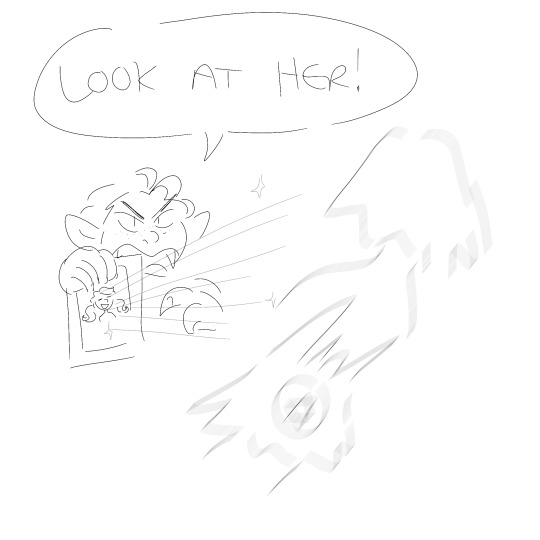
that's where she got the curls from!
#ganon draws#team rocket#danzo yasuke#he was a samurai in that old style town#a veteran from a long line of veterans#since kanto is so poor and fucked up with gangs cuz its just a war torn region#in fact james' parents company makes weapons and that's how they're so loaded#but thats lore for another time#well anyways why do you think james is such a good engineer after all 😭#but the region is so technologically behind cuz its a disaster area#WHAT WAS THIS ABOUT#oh right the prominence of samurai in the 1970s when jessie was born#yeah i was saying its cuz his surname is a reference to the story of that black samurai lol#did not mean to get into why kanto was stuck on phone booths while galar had rotom iphones.#<- i say this because if in theory pokeani takes place within a year then that means kanto had phone booths and bricks for pokedex#while other regions at the same time had way better stuff ash had to be introduced to#so i just interpreted that in my whole worldbuilding cuz im sooooo normal about pokeani#gancanons
9 notes
·
View notes
Text
punk-funk
not all projects are meant to be, it seems... I spent quite a bit of work on a genre submission for RYM recently that wasn’t able to make it through the queue, as many people thought it may not be well-recognised as distinct from its parent genre, dance-punk. I, however, think this is a really unique and interesting style within the development of post-punk and early blending between post-punk and alternative music with dance elements... so here is the description I submitted:
Punk-funk is a style of dance-punk which is based around incorporating funk rhythms into the minimal, angular sound of post-punk. Consequently, compared to other styles of punk, punk-funk is typically slower and groovier with a strong focus on the rhythm section, in particular emphasizing instrumental interplay and the bass guitar as a lead melodic instrument. Electric guitar is used more sparingly, typically played in a scratchy and rhythmic disco-influenced style. Some punk-funk groups also incorporate other rhythmic influences outside funk, most commonly the offbeat rhythms of reggae and dub; the complex percussive style of Afrobeat was also influential on some artists, most notably Talking Heads. Though less common, some punk-funk groups have also incorporated horns or saxophone.
The punk-funk style emerged effectively simultaneously on both sides of the Atlantic in 1979, in large part out of a desire to break from the white cultural norms (and racism) within the existing punk movement by prominently embracing Black musical influences. British punk-funk was primarily developed by Northern bands like Gang of Four (Leeds), A Certain Ratio (Manchester), and The Pop Group (Bristol), with a more reggae-oriented variant emerging from London's The Slits. Also notable is Public Image Ltd's "Death Disco" single; its title and "funk noir" became alternate names for the genre in the UK, emphasizing its darker tone compared to the dance styles it was inspired by. In the US, punk-funk emerged out of the art punk scene and closely related No Wave movement in New York City, with artists like James Chance and 99 Records' ESG and Liquid Liquid serving as a more rock-oriented counterpart to the mutant disco trend, which punk-funk sometimes crossed over with (earning it the nickname "mutant funk"). NYC scene mainstay Talking Heads swiftly incorporated a less angular variation on the style into their arty brand of new wave, serving as a major influence to bands in the emerging Athens, Georgia scene like The B-52's and Pylon.
Interest in the punk-funk sound declined by the mid-1980s, by which point many of these groups had broken up or moved onto new styles, but at the same time it was a major influence on New Order's emerging alt-dance tendencies and the proto-funk metal of Red Hot Chili Peppers (whose self-titled debut was produced by Gang of Four guitarist Andy Gill). Happy Mondays, innovators of the baggy sound later in the decade, also started their recording career as a punk-funk group. The style was revisited in the early 2000s by a number of groups associated with the post-punk revival and electroclash scenes, leading to the innovation of newer forms of dance-punk that build on and diverge from punk-funk with an array of influences from contemporary electronic and dance music to the aggression and intensity of post-hardcore and sasscore. However, some groups in this dance-punk revival like !!! still emphasized funk influences and can be seen as a modern continuation of the punk-funk sound. (fin)
you may espy the submission, discussion, and sourcing if you have a RYM account by accessing this link; the information primarily comes from Simon Reynolds’ Rip It Up and Start Again (2005) and Tim Lawrence’s Life and Death on the New York Dance Floor (2016), along with a smattering of web sources. both books are great, and I’d highly recommend checking out them or the listed artists if this music is of interest to you!
to end this, here’s a song from the LP that spurred me to look into this little movement in the first place, Pylon’s 1980 album Gyrate:
youtube
#punk#punk-funk#dance-punk#1970s#1980s#no wave#art punk#funk rock#post-punk#gang of four#a certain ratio#the pop group#the slits#public image ltd.#james chance#talking heads#pylon
7 notes
·
View notes
Text
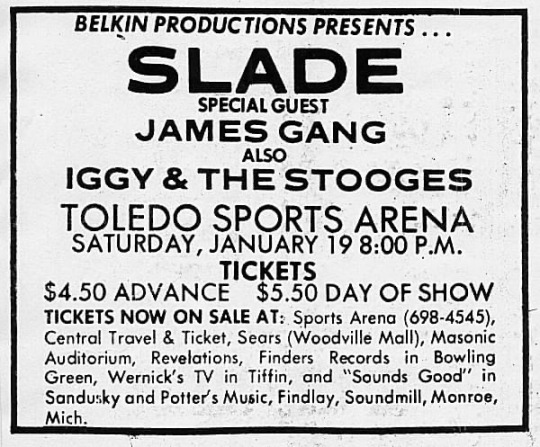
1974: Legendary pub-glam stompers Slade performed at the Sports Arena in beautiful and scenic Toledo, Ohio, with support from The James Gang and Iggy And The Stooges.
1 note
·
View note
Text



Heh remember when the man shut down what would have been the next answer to Woodstock and probably one of the greatest music experiences to man kind come 1970? Anyone? Gotta love New Jersey man.
#harmonyville#august#summer#1970#electric factory#woodstock#jefferson airplane#ten years after#chicago#procol harum#small faces#rod stewart#miles davis#hot tuna#jethro tull#james taylor#big brother and the holding company#van morrison#the james gang#mother earth#muddy waters#big momma thornton#shugie otis#archie whitewater#WHAT THE ACTUAL FUCK#savage grace#alice cooper#erick burdon and war#walpack#new jersey
1 note
·
View note
Text
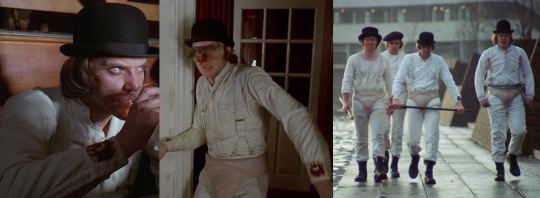

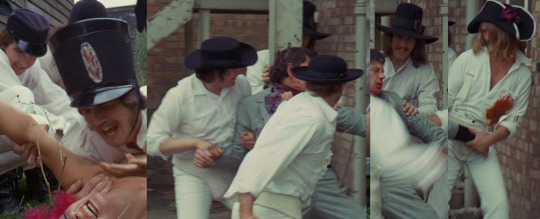
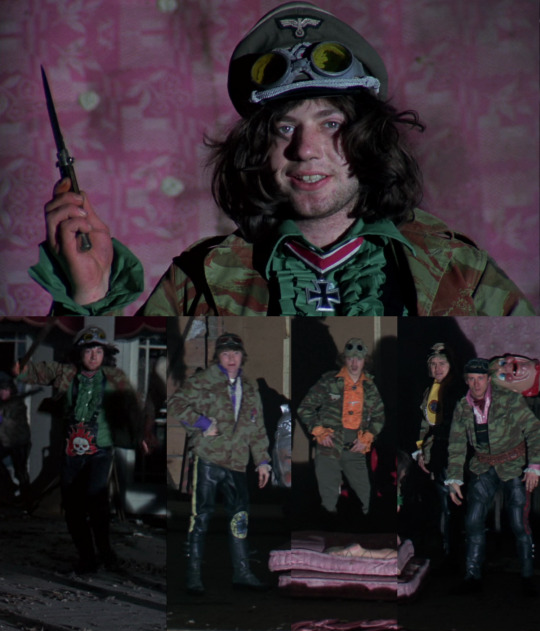
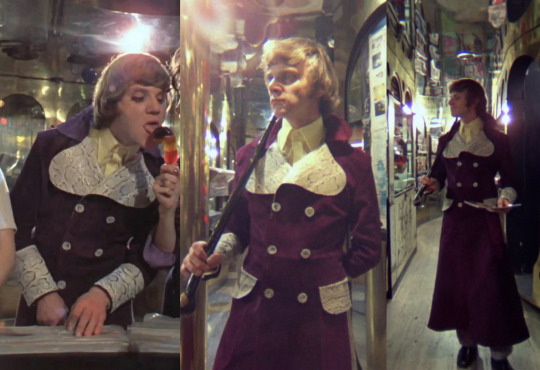
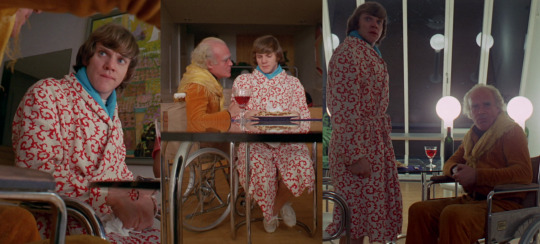

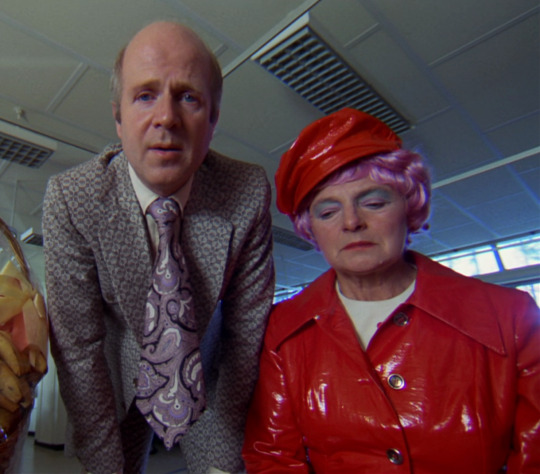
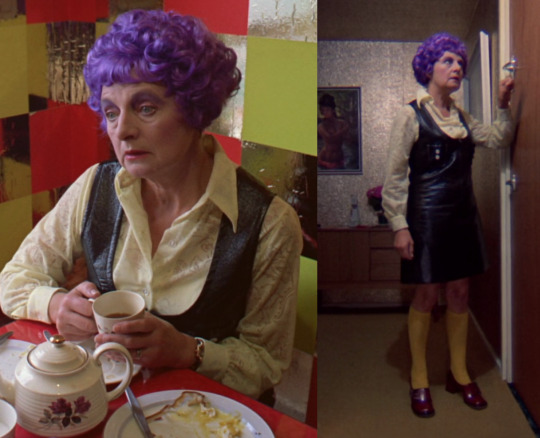



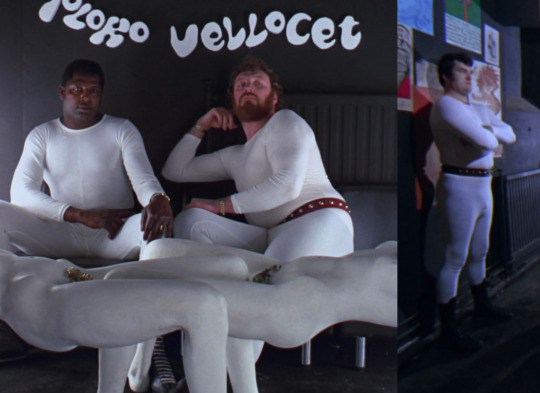
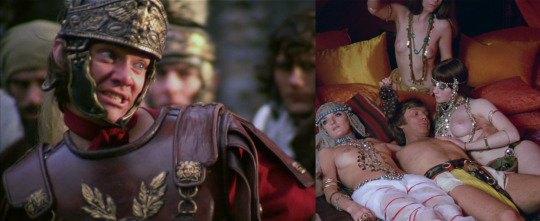

A Clockwork Orange (1971, dir. Stanley Kubrick) had Milena Canonero as costume designer in her first gig; the movie also was very low-budget (almost all of it was shot on location rather than in sets), so most of the costumes are off-the rack except for some of Alex's fantasy sequences where I'm sure it's reused period stock.
Canonero's Droog costumes however remains one of the most iconic costume designs in film history; the combination of underclothes, suspenders, old-fashioned hats and cricket codpieces. The asymmetrical makeup calls to mind tribal warriors but also adds a little androgyny (despite them all being vicious misogynists). The final touch is gore prosthetic decorations, such as the eyeballs on Alex's cuffs, that feel like a forerunner to punk fashion. This kind of DIY costume design was also done to excellent effect by Bobbie Mannix on The Warriors and Norma Moriceau on Mad Max 2.
There's some other nasty 'Droog' gangs too; one of the torture sequences (more harrowing cos Kubrick was being a sociopath again and had Malcolm McDowell's eyes being scratched for real) has some other Droogs in different hats, whilst Alex's nemesis 'Billyboy' (played by Richard Connaught) wears a very different kind of Droog uniform; consisting of leather overalls, military wear (especially WWII German military), and clashing colourful frilly shirts.
McDowell also gets to wear a fantastic purple suede and snakeskin jacket - prop sites say it was designed by Canonero, but the first comment on this Propstoreauction youtube video says something different 'I actually sold this coat to Malcolm around september 1970 in Kensington market in London , it is a plum suede and python trim coat designed and made by a young Yugoslavian guy and bought from our stock. the film’s costume designer had no imput. Malcolm chose it. Priced at £120 in 1970, it was the most expensive item in the market'. Interesting - given it only appears in one brief scene, it would make sense that it was bought. He also gets to wear a red and white nightgown that presumably was also off the rack.
As for the rest of the film's outfits? They all scream '1971' and were presumably off the rack. though almost all the women have had their hair dyed in garish colours. I love the red outfits worn by Sheila Raynor as Alex's mother, as well as the vinyl-lined red jumper worn by the unnamed lodger. Also the multicoloured dress worn by the psychiatrist, and the red jumpsuit worn by one of Alex's victims. Also the Milk Bar security who wear spandex unitards with studded belts, for some reason?
There's a couple of fantasy sequences that Alex indulges in, that I'm mostly including so that someone can hopefully indentify which film their costumes are from - he briefly has a fantasy of being a Roman soldier torturing Jesus, as well as being an ancient noble. Then he has one as a soldier in Old Testament battles; again, I highly doubt these were made for the film given the very low budget and the briefness of these fantasy sequences (clips from other movies were used in these fantasy sequences after all), but I did notice the helmets worn by his warriors were familiar - because they had been reused by costume designer James Acheson in the Doctor Who serial 'The Mutants' a year later!
#a clockwork orange#clockwork orange#stanley kubrick#1971#alex delarge#billyboy#malcolm mcdowell#richard connaught#sheila raynor#dystopia#scifi#science fiction#droogs
112 notes
·
View notes
Text
The Illustrious Client
First published in the US in 1924 and the UK in 1925, the latter as a two-parter, this forms part of Case-book.
The first part in The Strand ends with Watson seeing the newspaper headline about the attack on Holmes.
Northumberland Avenue is a street running from Trafalgar Square to the Thames Embankment. It includes a pub called The Sherlock Holmes.
The Carlton Club was founded by the Conservative Party and was long its defacto headquarters. Originally on Carlton Terrace, it moved to Pall Mall in 1835, with the building rebuilt in 1856. A direct hit by a German bomb in 1940 destroyed the building and the Club moved to 69 St James's Street, former home of Arthur's Club. Women were not allowed to be associate members until the 1970s and not full members until 2008, with Margaret Thatcher getting honorary membership when she become Tory leader in 1975. She later become club president in 2009, although by his point she had dementia and died in 2013.
The general consensus is that the "Illustrious Client" is no less than Edward VII himself, who Holmes may have previously gotten the Beryl Coronet back for.
Prague was then under Austrian rule.
The Splügen Pass, used for travel since Roman times, connects Switzerland and Italy and with its great height, hairpins and spectacular views, is considered one of the greatest driving challenges on the planet, having featured in Top Gear. The San Bernandino tunnel has taken most of the non-tourist traffic and it is now closed in winter for safety reasons.
Kingston upon Thames, known as Kingston for short, is a town located 10 miles SW of Charing Cross. Until 1965, it was in Surrey before becoming part of Greater London and part of the Royal Borough of Kingston upon Thames. Surrey County Council were based there until 2021, when their offices moved to Reigate.
The Hurlingham Club in Fulham is where horse polo's rules were established - it even hosted Olympic polo in the 1908 London Games, but the fields were compulsorily purchased by the local council after the Second World War for housing. It was also home to pigeon shooting and was home of world croquet, still holding major events in the latter. Edward VII was a keen patron of the site.
Charlie Peace was an English burglar and double murderer, executed in 1879. He ended up featuring in Madame Tussaud's Chamber of Horrors, which was oddly enough replaced between 2016 and 2022 with an immersive Sherlock Holmes Experience... which at £66.50 a ticket was a bit too expensive.
HMP Parkhurst, a Category B prison located on the Isle of Wight, merged in 2009 with HMP Albany to form HMP Isle of Wight, although each part retains its own name. Notable inmates include the Kray Twins, Peter Sutcliffe, Ian Brady and currently Serbian war criminal Radovan Karadžić.
Hypnotism was rather in vogue by this time.
Apaches were the name given to various criminal gangs in Paris; named after the Native American tribe. There are various suggestions as to how that came about.
Montmartre, in the 18th arrondissement of Paris, was widely known for its artistic community during this time, with many a famous name living there due to the low rents. It's still there and development is restricted due to the historic character. Pigalle, Paris's red-light district, is next door.
Kitty Winter would feature as a character in Elementary, played by Ophelia Lovibond. Gruner turns up as well.
"Tinker’s curse" is Kitty saying, in the language of the time, that she does not give an [expletive deleted].
Ruritania is a fictional country first featured in the 1894 Anthony Hope novel The Prisoner of Zenda. It has become a byword for quaint small European countries in Central and Eastern Europe.
China was still an Empire in 1902, nominally ruled by the Guangxu Emperor, aka Zaitan, but an 1898 coup resulted in his loss of any real power; he was even in house arrest for a while. He died in 1908, probably poisoned by arsenic. His nephew, Puyi, would be the last Chinese Emperor and is beyond the scope of this article.
I cannot discuss Chinese pottery in any depth and so will not attempt to.
Some husbands might have questioned the gallantry of King Edward VII, who had a box for his mistresses at his coronation.
Armorial bearings are the "shield" part of a coat of arms. The British royal one traditionally depicted a bare-breasted woman as part of the harp on the bottom left, but this is no longer standard practice.
Edward VII, while having no actual political power, was able to exercise quite a bit of influence behind the scenes, especially in foreign and defence policy.
All criminal prosecutions are brought in the name of the monarch, rendered "R" (Rex or Regina) in text and "the Crown" when spoken). i.e. R vs. Winter. In addition, judicial reviews (i.e. is this government decision legal) are also brought in the name of the monarch, with the name of the actual plaintiff in brackets since a 2001 change to the format, e.g. R (Smith) vs. Secretary of State for the Home Department. It is common for initials to be used in those brackets to protect the identity of a plaintiff, such as the recent decision on flying migrants to Rwanda.
#letters from watson#sherlock holmes#the illustrious client#illu#acd canon#factoids#history#Edward VII
25 notes
·
View notes
Text
RIP John Jakes, Pulp and Fantasy Author
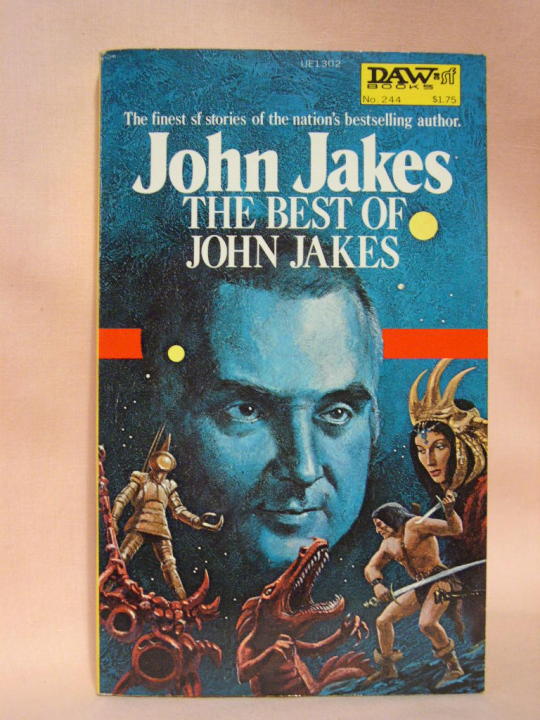
A man who’s career began in pulp scifi, then was one of the greatest group of fantasy fans turned authors, and who finally ended it as one of the most commercially successful “men’s adventure” paperback novels of the 1970s, John Jakes died at 90 last week. What a life! He started his career in scifi pulp of the 1950s, switching to sword and sorcery action in the 60s, and finally, ending the 70s as one of the top selling authors of the decade. In one guy’s life, you can see the ebb and flow of trends in men’s adventure fiction over the decades.

Let’s start the John Jakes story at the end, and then work our way back. Does this book series above look familiar to you at all?
If you have grandparents and they live in America, I 100% guarantee the Kent Family Chronicles (also called the Bicentennial Series) are in your Mee Maw and Pep Pep’s house right now. You probably handled them while visiting their house and went through their bookshelves as a child, right next to their Reader’s Digest condensed books, Tai-Pan and Shogun by James Clavell, copies of the endless sequels to Lonesome Dove, and old TV Guides they still have for some reason next to the backgammon set. If your grandparents are no longer with us, you probably found this series when selling their possessions after death. That’s because these things sold in the millions, back when the surest way to make money in writing was to write melodramatic, intergenerational family sagas of grandiose sweep set around historical events. Weighty family sagas, ones critics call bloated and self important instead of “epic,” were a major part of 70s fiction as they were four quadrant hits: men liked them for war, action, and history (every guy at some point must choose between being a civil war guy, or World War II guy) and ladies loved them for their romance and melodramatic love triangles (after all, the Ur-example of this kind of book is Margaret Mitchell’s Gone With the Wind). This was the kind of thing turned into TV event miniseries, and ably lampooned in the hilarious “Spoils of Babylon” series with Kristen Wiig and Toby McGwire, which, decades after the fact, did to this genre what Airplane! did for the formerly prolific airport disaster movie: it torpedoed it forever by making it impossible to take seriously.
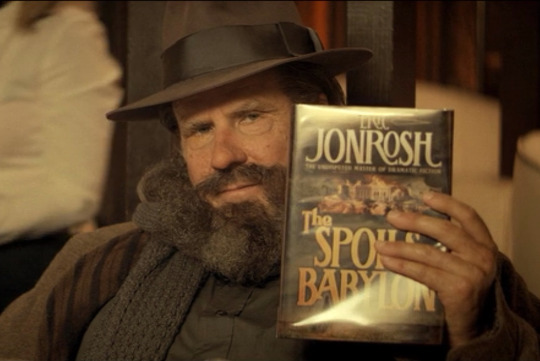
This genre eventually went away because men stopped being reliable book buyers and book readers in the 1990s (or at least, were no longer marketed to as an audience), Lonesome Dove’s insane popularity was the last gasp of this audience. I’ve said this before, but men and boys no longer reading is the single most under remarked on social problem we have. “YA books” now basically mean “Girl Books.”

John Jakes did not suddenly come out of nowhere to write smash hit bestsellers set around a family during the American Revolution. He came from one of the weirdest places imaginable: a crony of L. Sprague de Camp and Lin Carter in fantasy and weird tales fanzines like Amra, he was one of the original “Gang of Eight,” people drawn from fantasy and horror fandom to become pro-writers now that fantasy fiction had a home at Ballantine Publishing, just before the rise of Lord of the Rings and the paperback pulp boom, which is an incredible case of being in the right place at the right time. There, John Jakes, a fanzine contributor and ERB fan, wrote “Brak the Barbarian,” which is amazing as L. Sprague de Camp and Ballantine hadn’t even reprinted the Conan stories yet and Conan was as well known as Jirel of Joiry or Jules de Grandin. Only superfans of pulp knew who that guy was at all, there was no audience for it. He wrote Brak the Barbarian as a superfan, and was lucky the paperback market found him.

The tireless work John Jakes, Lin Carter, L. Sprague de Camp, and the Gang of Eight did in preserving fantasy novelists of the pulp age into the 50s-60s is one of the great historic feats of preservation and keeping fandom flames alive. It’s no exaggeration to say that you know who Conan the Barbarian and HP Lovecraft are right now because of them, fans who kept the flame alive tirelessly and thanklessly in the ultra-rational 50s that had no place for dark horrific fantasy.
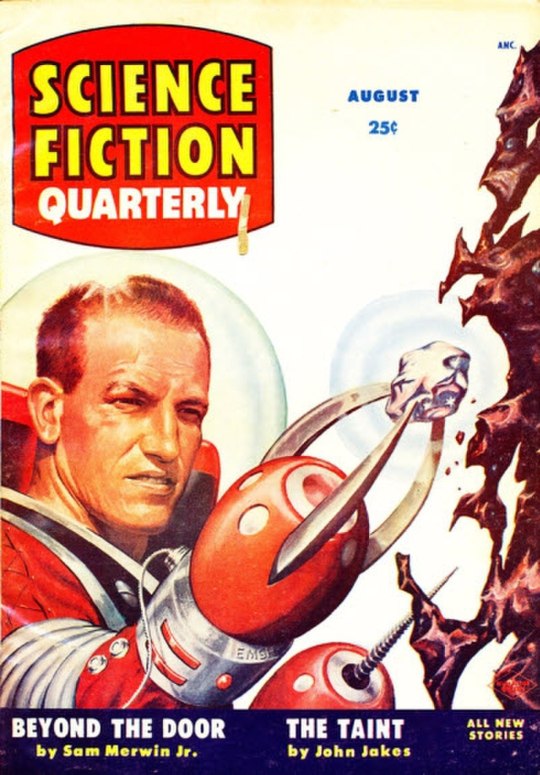
Like his friend in fantasy and pulp fandom, L. Sprague de Camp, John Jakes started as a scifi guy in the endless scifi pulp magazines of the 1950s. Unlike his friend de Camp or Hugh B. Cave, who were full of humor, characterization, and satire, Jakes was often pessimistic, dour, and downbeat, and he disliked to laugh.
It’s shocking to lose someone with a connection to, in one lifetime, the first great group of fantasy fandom, 50s scifi pulp, and 70s men’s adventure. John Jakes’ life spanned all of them.
72 notes
·
View notes
Note
I don't know how to ask this, but, like, I like reading Marauders content but sometimes I read some stuff about them that makes me think I'm a bad person for that. Like. They were bullies. So, isn't horrible that I like them anyways? How can I? Don't I think bullying is bad? Am I making light of how bad bullying is? I wanted to ask you what you think. Like, do you ever get affected by these feelings. Do you ever get affected by how other people see these characters. Do you ever get affected by people implying you are a bad person if you like character X?
Snape says they were bullies. Snape doesn’t tell us that far from being a harmless little loner, he was in fact hanging around with Mulciber and other mini wannabe Death Eaters (Sirius tells us). This gang bullied muggleborn Wix and called them slurs like mudbloods (Lily tells us), and we’re also involved in using dark magic against other students (Lily tells us Snape’s mates did this to Mary). Snape tries to pretend it was no big deal (it was a joke, he says) but Lily angrily disagrees. Snape used dangerous curses like Sectumsempra against people he hated eg James Potter, which btw he invented himself.
James used Levicorpus against Snape which btw was a curse that Snape had himself invented. James wasn’t happy that Snape was salivating with glee at the thought of discovering and proving Remus was a werewolf. Lily wasn’t happy either. Despite their rivalry, James saved Snape’s life when Snape made the dangerous and frankly terrible decision to follow Remus past the Whomping Willow on a full moon (yes Sirius was wrong to tell him but that still doesn’t make it his fault that Snape consciously/deliberately put himself in mortal danger to out one of his classmates because he hated them).
During 7th Year, when James had deflated his head a bit and was mature enough to be named head boy, Remus tells us this:
‘She started going out with him in seventh year,’ said Lupin.
‘Once James had deflated his head a bit,’ said Sirius.
‘And stopped hexing people just for the fun of it,’ said Lupin.
‘Even Snape?’ said Harry.
‘Well,’ said Lupin slowly, ‘Snape was a special case. I mean, he never lost an opportunity to curse James so you couldn’t really expect James to take that lying down, could you?’
Well, tbf, no, you couldn’t.
So you see, as far as I’m concerned, there were two gangs who were fighting a bit like the golden trio and Draco’s mates, and Snape was just as mean to James as the other way around?
But at least the marauders were fighting blood purist, racist, bigoted little shits who clearly made it known to everyone that they were planning on joining a murderous fascist- dictator type whose forces terrorised a minority group and were at war with innocent people (1970s Wix UK).
So the marauders went out of their way to antagonise these feckers (who clearly did the exact same thing to them). And? I’m not even sure that counts as bullying. It’s not very mature, and I’d prefer if they didn’t, but if my child went out of their way to antagonise bigoted eejits I’m not sure I’d be especially unhappy about it? I might even secretly be quite proud? 🤷♀️
#marauders fandom#Snape was a bully as a teenager#as we see in canon#but he continued being a bully as an adult#bullying kids#like orphans who happened to look like their nemesis in school#or muggleborn witches who were cleverer than purebloods#or sad boys whose parents were driven insane by other death eaters#now atHAT I would feel bad about ignoring#but#the marauders?#nah
21 notes
·
View notes
Text

#love#arthur lee#james gang#black sabbath#fillmore west#1970s#hearat shaped#norman orr#rock and roll hall of fame
9 notes
·
View notes
Text
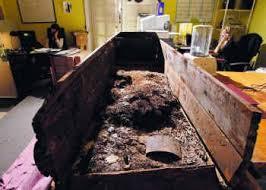
Upon occasion a body must be exhumed or done so by accident. Some exhumations can reveal unusual finds and many famous people who were exhumed are documented by curious witnesses. There is quite a list of famous people who were exhumed for one reason or another. Some of them include:
Daniel Boone – He was buried in Missouri but when moved to Kentucky, they thought they might have the wrong body.
John Wilkes Booth – His body was warehoused until his family finally put him to rest in their area.
Al Capone – His body was moved.
Karen Carpenter – In Karen’s case, they wanted to move her to a new location.
Christopher Columbus – His body had been moved around and so there was some question about whether the remains were his or possibly mixed with another person.
Marie Curie – Her body was exhumed and moved to be put in a place of honor.
Sammy Davis Jr. – Sammy died almost bankrupt so his wife actually had him exhumed to get the 70,000 dollars worth of jewelry he was buried with.
Adolf Hitler – In 1970, remains believed to be his were turned over for cremation.
Benny Hill – Sadly, this beloved comedian was the victim of grave robbery.
Abraham Lincoln – Several people thought to try and steal his body. Eventually, they encased him in concrete.
Lee Harvey Oswald – With the permission of Oswald’s widow, Eddowes had the body exhumed in 1981 and dental records confirmed the man was not a Russian body double, but Oswald himself.
Elvis Presley – Buried in Memphis, he was moved because someone tried to steal his body. He was placed at Graceland
Jesse James – The infamous Wild West outlaw may have died in 1882, but his legend lived on as did persistent rumors that James faked his own death. In 1995, the James family requested the exhumation of their ancestor’s corpse from a Kearney, Missouri cemetery and DNA tests confirmed the remains were indeed those of the outlaw.
Eva Peron – Evita’s body was exhumed and moved to Madrid, where her husband lived in exile. Finally in 1974, her remains were returned to Buenos Aires and buried in a fortified crypt in La Recoleta Cemetery.
Abraham Lincoln – In 1876 a gang of Chicago counterfeiters hatched a scheme to snatch the slain president’s body from his tomb in Oak Ridge Cemetery in Springfield, Illinois, and hold the corpse for a ransom of $200,000 and the release of their best engraver from prison. After law enforcement officials thwarted the grave robbers in the middle of the crime, Lincoln’s body was quickly moved to various unmarked graves until it was eventually encased in a steel cage and entombed under 10 feet of concrete in the same Springfield cemetery in 1901.
Zachary Taylor – In 1991, Taylor became the first president to have his remains exhumed, and tests conclusively showed that he was not assassinated by poison.
Oliver Cromwell – King Charles II exhumed Cromwell’s body on the twelfth anniversary of his father’s execution and in retribution for the regicide staged an execution of his own.
Simon Bolivar – Twelve years after his death, Bolivar’s remains were exhumed from Santa Marta’s cathedral and transferred to Caracas, Venezuela. The testing by forensic specialists proved inconclusive as to the cause of Bolivar’s death.
8 notes
·
View notes
Text
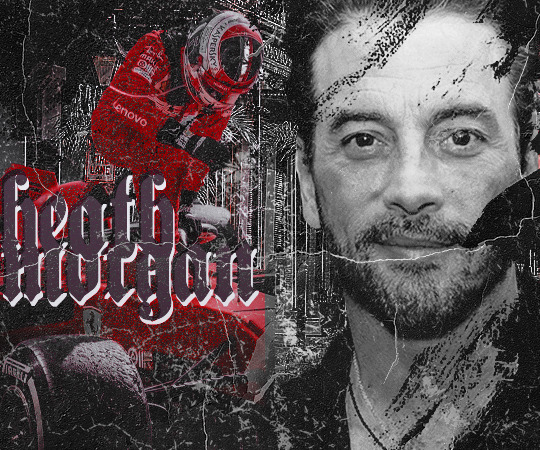
[ skeet ulrich — 53 — he/him ] Introducing HEATH JAMES MORGAN . Word on the street is they are a RETIRED F1 DRIVER / CAPTAIN and member of THE BROTHERHOOD for the past TEN YEARS . Though they are DEMANDING and BRUTAL , they can also be INCISIVE and AUTHORITARIAN . In the chaos of New York City, they’re sure to fit right in.

— BASICS.
Name: Heathcliff James Morgan
Nickname: Heath
Age / D.O.B.: 53 / March 22, 1970
Gender, Pronouns: Cisman. He/Him
Sexuality: Heterosexual
Hometown: Dallas, Texas
Occupation: Retired F1 driver / Captain
Affiliation: The Brotherhood
Languages: English, Spanish, Italian, French
Relationship Status: Single
Children: One

— APPEARANCE.
Hair Color: Black
Eye Color: Dark Brown
Height: 6 ft

— STATS.
Personality Type: ENTP
Moral Alignment: Chaotic Evil
Positive Traits: Indomitable, Eloquent, Assertive, Cunning, Dominant, Ambitious, Bold, Decisive, Resourceful, Self Disciplined, Confident, Perceptive
Negative Traits: Brutal, Volatile, Manipulative, Cynical, Rough, Competitive, Vengeful, Malicious
Mental Health: (Undiagnosed) NPD
Narcotics of use: Cocaine

— FAMILY .
Parents: Clark Morgan, Midge Davis
Siblings: TBD Morgan
Cousins: TBD
Children: Willa Morgan ( NPC )

— BIOGRAPHY .
Heath was born in Dallas. His mother was a burlesque dancer and his dad a mechanic. His mother was an alcoholic and abusive, she also struggled with drug addiction and would constantly disappear from home for weeks at a time. His father got tired of this and moved with his children to a trailer park, where he raised them as a single dad.
His father was part of a motorcycle gang, mostly former by getaway drivers with criminal ties, the kids spent much of their time under their protection, they considered them family and that was where Heath developed his passion for cars.
He started driving karts, the first step in the craft of racing, learning from control to adapting to the race track for speed. He entered karting competitions, was skilled and started to attract attention from sponsors. Different local and national competitions, getting a few good wins under his belt.
His father was killed in a confrontation between the group and the police, which made Heath responsible for his younger sibling. Due to family connections, they find their way to NYC. Necessity made him join the criminal world for a quick way out, doing the unimaginable to guarantee their survival since they no longer had protection.
He built for himself a small group of criminals that he had met along the way, they lived in the shadows. Started with small thefts and riots, until they evolved into kidnapping, blackmailing, extortion - and murder. yes, they knew it would reach extreme measures as soon as attacks on government buildings and high ranking individuals started to happen. It was a common fact among the powerful, they always had the fire lit faster when someone was about to die. And he wanted that kind of attention.
As the years went by he could see the improvement, they were far from being rich but now they had their own small house and were comfortable for the first time. Decided to return to amateur kart competitions and attended different educational programs pursuing technical and mechanical backgrounds knowledge. Sponsorship and funding allowed him to get his full competition license, building a career.
After getting a FIA international grade A license, he began competing in the lower-tier series, getting the right kind of networking and catching the attention of team owners, opening doors to opportunities in high levels of F1.
Heath was superior to the majority. Amidst the clamor, the chaos, the endless hours of practice, he remained unbroken, untouched. His power hunger surpassed that of his peers, a relentless drive to go beyond, delve deeper, and endure farther. While many found themselves in a competition for attention - he simply prevailed, unequivocally. And he deserved it. He deserved to be seen and be heard, eat the rich as they devour everything around them.
Everyone who crossed his path tried brutally to tame him, breaking him into a thousand pieces, tirelessly seeking to reshape into different individuals. His essence could never be affected, you cannot corrupt something that has been rotten for a long time. He could feel all that poison in his blood, every step he took was like the tick tock of a time bomb about to burst - all those vile urges were devouring him from the inside out.
After winning F1 world championship for the eighth time ( six times consecutively) at forty, he decided to retire. He got bored. Not just of his career, but everything else. Contacts with shady sponsors allowed him to achieve even more exclusive cycles, and consequently even more skeletons in his closet.
Do you remember the small group of criminals from his teenage years? Now with more available resources, he joined a bigger version of it, even more lethal. The Brotherhod. Meticulously chosen individuals, whose every weakness could be exploited and shaped into a weapon.
The common enemy remained the same: government, with no prospect that that target would ever change. New adversaries appeared on the way, more organizations than they could count, but nothing that couldn't be turned into a vile public message of what would happen to anyone who got in their way.

— F1 TIMELINE .
1988 : got his FIA international grade A license. he was 18
1991 : started competing for ferrari. he was 21 years old
1992 - 1999 : won six world titles consecutively
2000 : signed with mclaren.
2007 : won his seventh world title
2009 : won his eighth and last world title
2010 : retired. 40 years old
7 notes
·
View notes
Note
I've gotten into a 1600s matchlock mood recently and I watched a Swedish documentary that tried to dispel nationalist myths about the 2632 battle of listen (their actual words Idk I don't remember convos very well but they said nationalism and glory days myths)
Any way stupid intro to question: did sweden have any specific kind of cavalry horse or did they just grab whatever?
(A US civil war/native extermination said the US bought what horse was brown and had the right temperment)
And is there any kind of *shift* in how cavalry has been portrayed in art? Like are there certain poses lighting whatever that's been slowly removed or put in?
I think this is probably from my notice of how Cromwell (1970) and alatriste (2006). Cromwell shows the battle of edgehill and naseby as big romps in a field with pretty flags and uniforms vs alatristes siege of Breda and battle of rocroi that are more like loosely organised gang fights. Cromwell: very clean, pretty festive even. wide shots for the spectacle. Alatriste: everyone is in a shade of brown. The blood flows freely. You are up in the men's faces as they are stabbed repeatedly.
Maybe what I'm saying is if a dramatic change like that in thirty years what about 300+ years?
Or am I just seeing shapes in smoke?
To make this a little simpler I've boiled down your questions a bit so I can group my answers to them more clearly. I hope you don't mind that I focused a bit more on the first question since I felt I could give it the best answer.
What kinds of horses were used by the Swedish cavalry?
Sweden didn't have a regular cavalry until king Gustav Vasa (r. 1523-1560). In the cavalry there was a preference for stallions initially, since mares and geldings were thought to lack the strength and bravery needed in battle, but with the outbreak of war in 1700 they shifted to using geldings. Mares and stallions were instead kept at home to insure the breeding of new horses even as war was ongoing. In 1658 Sweden gained new territory further south (Skåne) that was well suited for breeding horses which greatly aided its efforts in supplying horses to the army. The average mount served for 15 years in the Carolean cavalry wich meant each year 350 newly ridden in horses were needed. These horses weren't that big by continental standards, being on average about 139 cm tall at the withers. Compare that to the requirements of the late 1900s when they had to be at least 152 cm and you get sense of the significant change that took place. By the mid 1700's each cavalry company had three stallions and twenty-odd mares to produce replacement mounts. There were some small changes in the early 1800's to this system. (Source)
King Karl XI (r. 1660-1697) instituted studs in Strömsholm, Kungsör, and Läckö to improve the quality of horse breeding. He also imported stallions from Norway, Swedish Livonia (parts of modern day Estonia and Latvia), Swedish Pomerania, and France with the same goal in mind. (Source)
Nowadays the Beriden Högvakt (mounted guards) in Stockholm use only Chestnut Swedish Warmbloods, Grey Kladrubers and a couple of draught horses as drum horses. (link to a Swedish article with more info)
How has the depiction of cavalry changed through time?
Your other question about depictions of cavalry is an interesting one, and I would just from what I have seen say that there is a movement form more composed images to dynamic and later more grounded/gritty depictions of horses in war. The pinnacle of this latter form being in WW1 in my opinion (this was probably helped by the work of war artists like Alfred James Munnnings, John Edwin Noble, etc). You can in all likelihood map this evolution on to more general societal/cultural feelings about war and as to whether it was seen as being glorious or a tragedy. Also the fact that the horse was becoming more obsolete during WW1 probably helped remove some of the glory from the art of the time. If you think about paintings from a bit earlier (the late 1800's) where there are still plenty of paintings of glorious cavalry charges it makes quite a contrast to the art of WW1.
I think you can look at this question through the lens of what is happening culturally but also in art history, especially with regard to your question about poses and lighting. For example a painting of cavalry from the Romanticism movement is going to look quite different from something done in a more realist style.
I don't feel like I've got the time to give this question the attention it deserves here so I'll leave it as it is for now, but I'll do my best to return to this question and give it a more complete answer. Also I've only written about European art in my answer which doesn't tell the whole story.
#horses in art history#the sources linked in my first answer go to pages in swedish but i thought i might have some Swedish followers who were interested#also it feels like the correct thing to do
12 notes
·
View notes